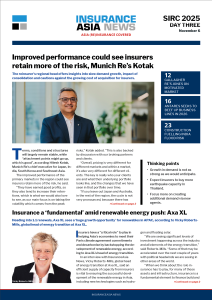SIRC: Southeast Asia’s regulatory changes could be a springboard for transformation
November 6 2025 by Mithun Varkey
Southeast Asia’s regulatory shifts, while appear challenging, offers an unparalleled opportunity for forward-looking (re)insurers to drive innovation, foster consolidation and unlock new avenues of growth, said Jasmine Miow, head of South Asia and Southeast Asia markets, Peak Re.
“Many of the region’s insurance markets are undergoing their most significant regulatory updates in decades.
“Supervisory authorities in Indonesia, Malaysia, Vietnam, the Philippines, and Thailand are tightening capital regimes, raising solvency minimum requirements, and encouraging more robust risk management practices,” Miow said.
In Indonesia, phased increases will require insurers to hold up to IDR1 trillion (about US$60 million) in capital by 2028 – setting one of the highest capital thresholds in Asean.
“This move is widely expected to lead to a wave of industry consolidation, as smaller and mid-sized insurers seek new investors, partners, or acquirers to meet the heightened requirements,” she said.
Malaysia is preparing to implement the Risk-Based Capital 2 (RBC2) framework, Philippines maintains its current minimum capital requirements with potential regulatory updates under evaluation for future implementation. Vietnam is implementing a phased transition to update its regulatory requirements, with some capital raising activity observed as insurers prepare for future growth.
In Thailand, the Office of Insurance Commission (OIC) is enhancing prudential oversight by integrating catastrophe risk into capital adequacy standards to strengthen industry resilience.
The Myanmar earthquake in March, with tremors felt in Bangkok, highlighted the region’s underestimated cat exposure. The OIC is using this as a case study to launch three phased actions this year, to improve awareness and readiness.
Taken together, these changes reflect Southeast Asia’s steady progress towards more robust, riskbased oversight.
“While these changes create immediate operational and financial challenges, they are fundamentally designed to enhance the stability and sustainability of Southeast Asia’s insurance sector,” Miow noted.
“Stronger capital positions mean greater protection for policyholders and a more resilient foundation for the industry’s continued development.”
Strategic levers 
In the emerging regulatory environment, simply meeting minimum capital requirements is not enough, according to Miow.
“The ability to effectively manage capital and optimise balance sheets has become a powerful differentiator. Insurers that can adapt quickly to new rules and deploy capital efficiently will be best positioned to capture emerging opportunities as the market evolves,” she added.
“Peak Re believes that regulatory change is not just about compliance, but also about using capital management strategically to foster growth. For example, as consolidation accelerates, we work closely with clients to design bespoke reinsurance solutions and structured transactions that ease capital constraints, support M&A, and facilitate portfolio optimisation.”
For smaller players, this might mean finding the right partner or investor; for larger insurers, it could involve innovative capital solutions, she explained.
Building scale
One of the most immediate consequences of rising capital requirements is industry consolidation.
“This environment, while challenging, creates opportunities for stronger players to build scale, diversify risk, and enhance operational efficiency through well-executed mergers, acquisitions, or strategic partnerships,” Miow said.
“The current wave of regulatory change is not an obstacle, but a springboard for transformation. Insurers and reinsurers who approach compliance as the foundation for innovation and long-term growth will be best positioned to shape the region’s future,”
“At Peak Re, our strength lies in our diverse team of regional experts with a global perspective,” she added. “Working across markets with unique dynamics allows us to better understand clients’ evolving needs.”
The reinsurer’s approach, Miow said, centres on three pillars: bespoke reinsurance structures that optimise clients’ capital positions; local expertise that reflects market nuances, and agile support that ensures capital is deployed where it creates the most value.
-
Beazley | What does cyber protection look like from day 1 to day 600 and beyond?
Cybersecurity is no longer just an IT concern, but a governance issue that belongs on the boardroom agenda.
-
Sedgwick | Preparing for the next storm
Insurance industry needs to recalibrate, invest in innovation and strengthen systems, talent and data practices.
-
Peak Re | From climate modelling to market opportunity: Forging a new clarity on Southeast Asia’s climate risk
Southeast Asia's protection gap: a crisis of clarity, not just capital
-
BHSI WICare+ | Accelerating Payments, Empowering Recovery
Launched in cooperation with Steadfast’s Singapore network, WICare+ fills the gaps found in traditional coverage and keeps businesses and their workforce secure by covering up to SG$350,000 in medical expenses per claim.

